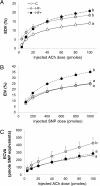Body adiposity dictates different mechanisms of increased coronary reactivity related to improved in vivo cardiac function
- PMID: 24572210
- PMCID: PMC3996056
- DOI: 10.1186/1475-2840-13-54
Body adiposity dictates different mechanisms of increased coronary reactivity related to improved in vivo cardiac function
Abstract
Background: Saturated fatty acid-rich high fat (HF) diets trigger abdominal adiposity, insulin resistance, type 2 diabetes and cardiac dysfunction. This study was aimed at evaluating the effects of nascent obesity on the cardiac function of animals fed a high-fat diet and at analyzing the mechanisms by which these alterations occurred at the level of coronary reserve.
Materials and methods: Rats were fed a control (C) or a HF diet containing high proportions of saturated fatty acids for 3 months. Thereafter, their cardiac function was evaluated in vivo using a pressure probe inserted into the cavity of the left ventricle. Their heart was isolated, perfused iso-volumetrically according to the Langendorff mode and the coronary reserve was evaluated by determining the endothelial-dependent (EDV) and endothelial-independent (EIV) vasodilatations in the absence and presence of endothelial nitric oxide synthase and cyclooxygenase inhibitors (L-NAME and indomethacin). The fatty acid composition of cardiac phospholipids was then evaluated.
Results: Although all the HF-fed rats increased their abdominal adiposity, some of them did not gain body weight (HF- group) compared to the C group whereas other ones had a higher body weight (HF+). All HF rats displayed a higher in vivo cardiac activity associated with an increased EDV. In the HF- group, the improved EDV was due to an increase in the endothelial cell vasodilatation activity whereas in the HF+ group, the enhanced EDV resulted from an improved sensitivity of coronary smooth muscle cells to nitric oxide. Furthermore, in the HF- group the main pathway implicated in the EDV was the NOS pathway while in the HF+ group the COX pathway.
Conclusions: Nascent obesity-induced improvement of cardiac function may be supported by an enhanced coronary reserve occurring via different mechanisms. These mechanisms implicate either the endothelial cells activity or the smooth muscle cells sensitivity depending on the body adiposity of the animals.
Figures


References
-
- Coelho DF, Pereira-Lancha LO, Chaves DS, Diwan D, Ferraz R, Campos-Ferraz PL, Poortmans JR, Lancha Junior AH. Effect of high-fat diets on body composition, lipid metabolism and insulin sensitivity, and the role of exercise on these parameters. Adv Physiol Educ. 2011;44(10):966–972. - PubMed
-
- Daly ME, Vale C, Walker M, Alberti KG, Mathers JC. Dietary carbohydrates and insulin sensitivity: a review of the evidence and clinical implications. Am J Clin Nutr. 1997;66(5):1072–1085. - PubMed
-
- Tiwari S, Ndisang JF. The role of obesity in cardiomyopathy and nephropathy. Curr Pharm Des. 2013. p. .. [Epub ahead of print] - PubMed
Publication types
MeSH terms
LinkOut - more resources
Full Text Sources
Other Literature Sources
Medical
Research Materials
Miscellaneous

